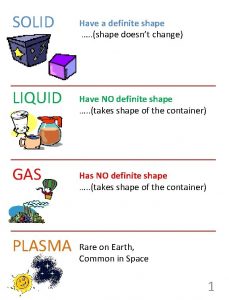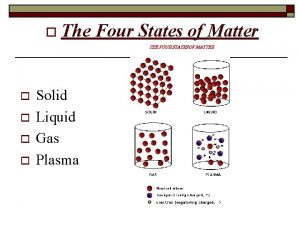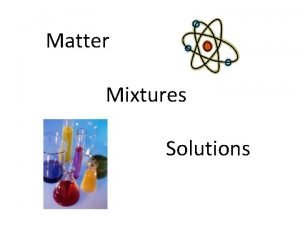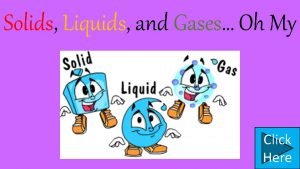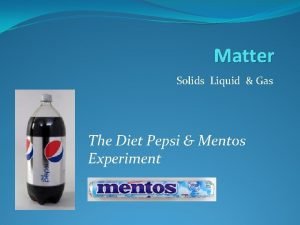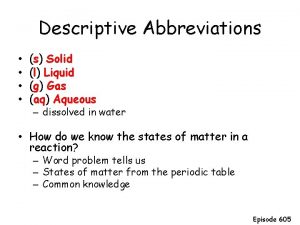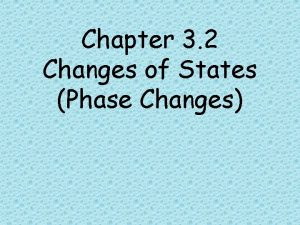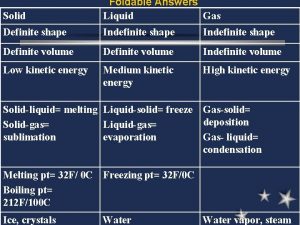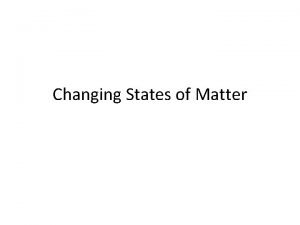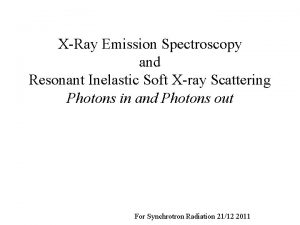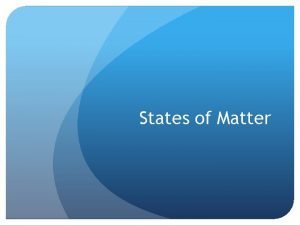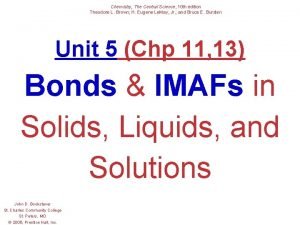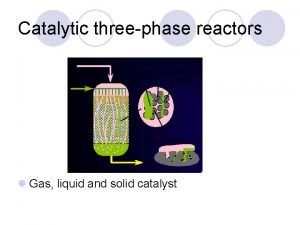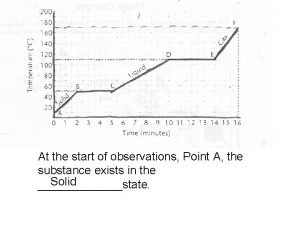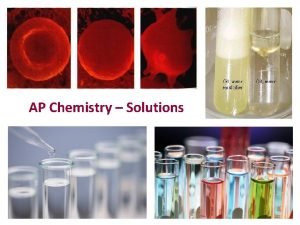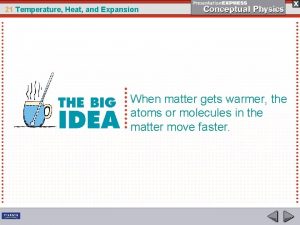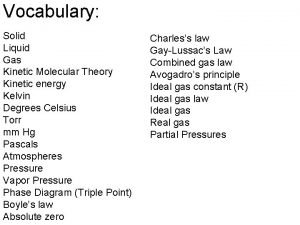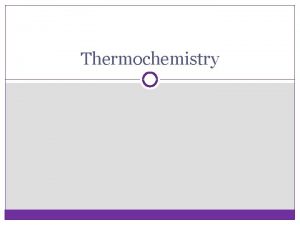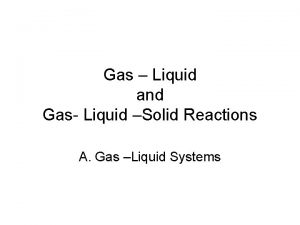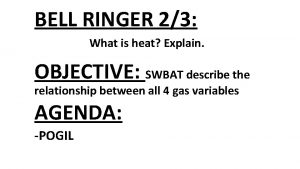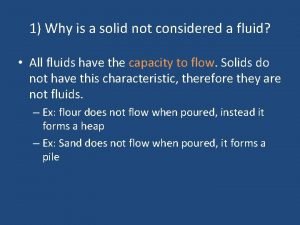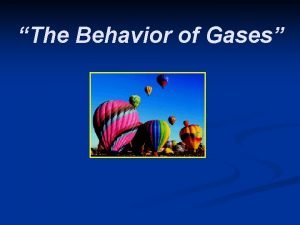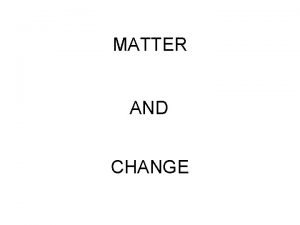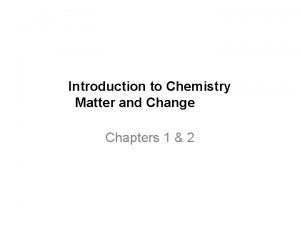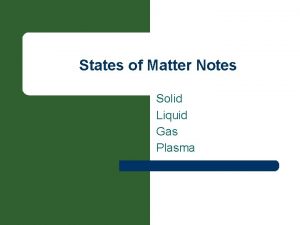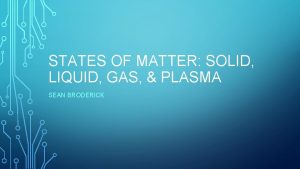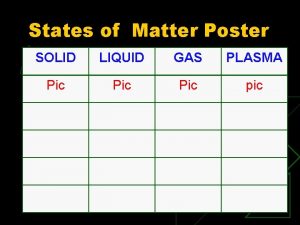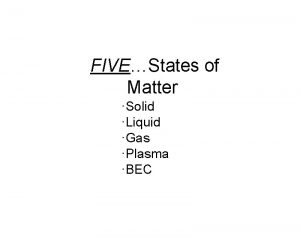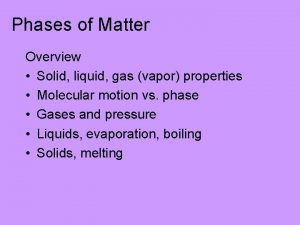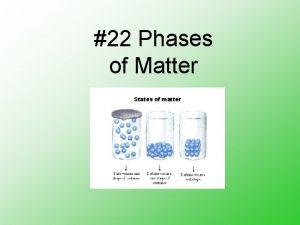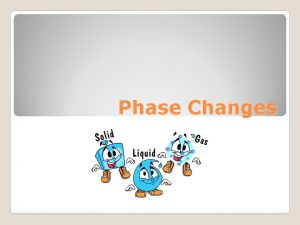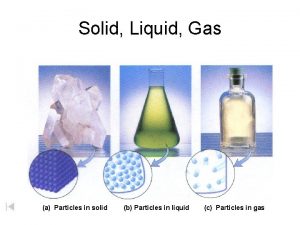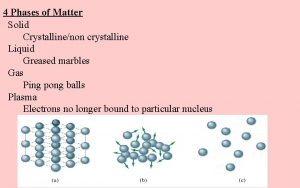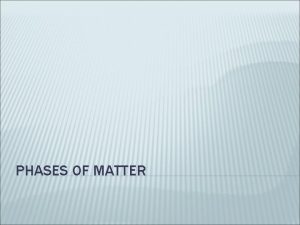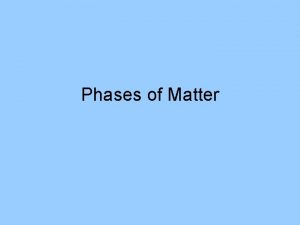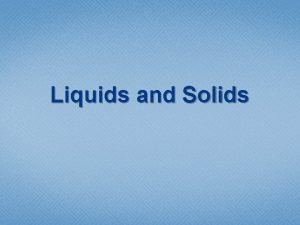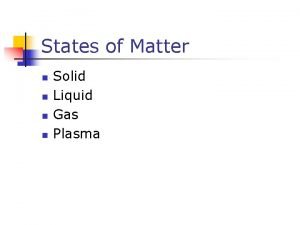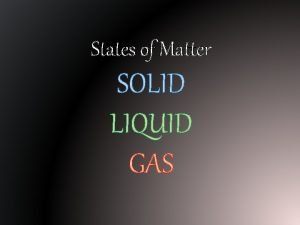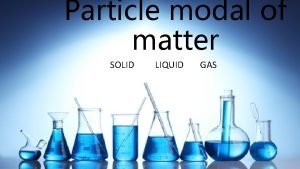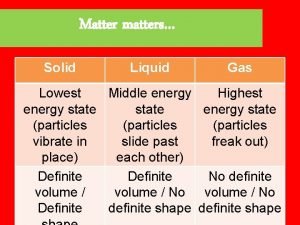Phases of Matter Phases Solid Liquid Gas Plasma



































- Slides: 35

Phases of Matter

Phases • Solid • Liquid • Gas • Plasma

Phases of Matter • IMF’s explain the phases of matter • Solid • Particles move relatively slow (basically vibrating in fixed position) • IMF’s hold them together • Liquid • Particles move more (able to flow past each other) • IMF’s still hold together but not as tightly • Gas • Particle move quickly (each in rapid, random motion) • Little to no IMF’s (we usually assume none)

Intermolecular forces are very important. of little significance Intermolecular forces must be considered.

Solid Particles relatively close together Retains volume and shape Relatively high densities Hard to compress Does not flow easily Types • Crystalline- regular order/ pattern to particles • Amorphous- no regular pattern to particles

Liquid Particles more spaced apart Retains volume but not shape Intermediate densities Hard to compress Flows easily (Fluidity) Slow faster than others Viscosity- measure of the resistance to flow in a liquid Stronger IMF’s lead to higher viscosity Can diffuse- liquid molecules spread out through another liquid Can display surface tension- attraction of molecules at surface to each other (Stronger IMF’s lead to more surface tension) Can display capillary action- attraction of liquid to solid surface causing it to flow


Gas Particles spaced very far apart Does not retain volume or shape Very low densities Compressible Flows easily (fluidity) Can diffuse and go through effusion Elastic collisions (no loss of energy during collision) Ideal vs Real Gases Ideal- no attraction between particles Real- gases where particles are attracted to each other

Plasma • Occurs at very high temperature and pressures • Also a fluid • Mix of neutral atoms, free electrons, and ions

Density Physical, intensive property Mass per unit volume of substance (D= m/V) Units Solids and Liquids g/cm 3 or g/ml (1 cm 3 = 1 ml) Gases g/L Density controls placement of fluids and solids Less dense objects or fluids move to the top More dense objects or fluids move to the bottom

Density (cont) D = m/V Mass Measured on a balance Volume Solid Regular Shape- can be calculated from other measurements Irregular Shape- can be found by water displacement method Liquid and Gas Can be measured with instruments such as graduated cylinder

Heat • Amount of energy transferred from one substance to another • Represented by q with units in Joules (J) • When heat transfers, it affects the temperatures of the substances

Temperature • Measure of the average kinetic energy in a sample • High temperatures mean the particles are moving quickly • Theoretically if the particles weren’t moving at all, the temperature would be 0 Kelvin (absolute zero) • Remember K = °C + 273. 15

Heat Flow • Heat will “flow” from the substance with a higher temperature to the substance with a lower temperature • As the faster particles collide with slower particles, the faster ones will slow down and the slower ones will speed up

Heat and Temperature Change • When heat transfers, it affects the temperatures of the substances involved in the transfer • How much will the temperature change? • Dependent on • Amount of heat transferred • Mass of the sample • Composition of the sample

Amount of Heat Transferred • The more heat transferred, the greater the temperature change • If heat is absorbed by the sample • q is positive • Final temperature will be higher than the initial temperature • If heat is lost by the sample • q is negative • Final temperature will be lower than the initial temperature

Mass of Sample • A heat transfer will cause a bigger temperature change to a smaller mass than it will to a larger mass.

Composition of the Sample • Different substances absorb/release heat in different ways. • Specific heat (c) – is the amount of heat needed to change 1 gram of a particular substance by 1 °C. • Each type of substance has a different value

Specific Heat Equation • • • q= mc T q is heat m is mass c is specific heat T is change in temperature • Tf-Ti (final temperature – initial temperature) • Units need to match • For instance, if the specific heat value is given in J/g°C, heat should be in J, mass in grams, and temperature in °C

Calorimeters • Instrument used to measure heat transfer • Process allows water and another substance to undergo a heat transfer until both are at the same temperature (thermal equilibrium) • This means the heat gained (or lost) by the water equals the heat lost (or gained) by the substance

Absorbing Heat • Solid absorbs heat and temperature increases (molecules moving faster) • Reaches a point that movement weakens IMF’s enough to allow flow (melting point) • Heat is still absorbed but temperature does not increase • Liquid absorbs heat and temperature increases (molecules moving faster) • Reaches a point that movement weakens IMF’s enough that they essentially no longer exist (boiling point) • Heat is still absorbed but temperature does not increase • Gas absorbs heat and temperature increases (molecules moving faster)

Heating Curve • Plateaus at melting point • Heat still added • Used to weaken IMF’s • Called Heat of fusion • Another longer plateau will occur between liquid and gas • Called heat of vaporization

Releasing Heat • Heat is released from the gas and temperature decreases (molecules moving slower) • Reaches a point that molecules are close enough for IMF’s to be reestablished (condensation point) • Heat is still released but temperature does not decrease • Heat is released from the liquid and temperature decreases (molecules moving slower) • Reaches a point that molecules are close enough for IMF’s to strengthen (freezing point) • Heat is still released but temperature does not decrease • Heat is removed from the solid

Heating/Cooling Curve

Phase Changes Solid Liquid = Melting Liquid Solid = Freezing Occurs at melting/ freezing point Liquid Gas = Evaporation/Vaporization/Boiling Gas Liquid = Condensation Occurs at boiling/condensation point • Solid Gas = Sublimation • Gas Solid = Deposition

Evaporation or Vaporization • Evaporation • Occurs at temperatures below boiling point • Some molecules have enough energy to escape surface of liquid • Vaporization • Occurs at boiling point • Change to gaseous phase occurs throughout liquid

Phase Change (cont) • Freezing point and Melting point • Same thing (occur at same temperature) • Named depending on the direction compound is going • Condensation point and Boiling point • Same thing (occur at same temperature) • Named depending on the direction compound is going Each substance has its own points and heats (fusion and vaporization)

Influencing Points • Same substance • Pressure (mostly sways boiling point) • “Normal” points are points at standard pressure (1 atm) • Lower pressures allow particles to spread out more (IMF’s can be overcome at lower temps) • Higher pressures compress molecules (Higher temp needed to overcome IMF’s) • Between different compounds • Strength of forces holding particles together • • Metallic Bonds Ionic Bonds Covalent Bonds IMF’s


Boiling Point • Vapor pressure- Partial pressure of gas particles of substance over the liquid of that substance • Vapor pressure increases with temperature • More particles have energy to escape surface • Point at which vapor pressure of substance is equal to atmospheric pressure

Phase Diagram • Chart for each substance showing the temperature for phase changes according to pressure • Crossing a line indicates a phase change


Phase Diagrams (cont) • At any pressure, a horizontal line can be drawn. • Temperatures of phase changes are found where lines are crossed • The “normal” points are found by drawing a horizontal line at 1 atm of pressure


Phase Diagrams (cont) • Triple Point • Pressure and Temperature where all three phases can be found • Critical Point • Critical Temperature- highest temperature that the liquid phase of a substance can be found • Critical Pressure- pressure at critical point • Beyond this point the liquid and gas phase in indistinguishable (super critical fluid)
 Solid liquid gas plasma
Solid liquid gas plasma Plasma particles arrangement
Plasma particles arrangement States of matter solid liquid gas
States of matter solid liquid gas States of matter concept map
States of matter concept map Solid
Solid Solid liquid and gas molecules
Solid liquid and gas molecules Venn diagram matter
Venn diagram matter Properties of a solid
Properties of a solid Pepsi and mentos
Pepsi and mentos Abbreviation for solid in chemistry
Abbreviation for solid in chemistry Gases are easily compressed because of the
Gases are easily compressed because of the Combined gas law def
Combined gas law def Solid liquid gas phase change
Solid liquid gas phase change Gas laws foldable
Gas laws foldable Mixture matter graphic organizer
Mixture matter graphic organizer States of matter map
States of matter map Gas liquid solid
Gas liquid solid Sound is
Sound is Solid liquid gas particles
Solid liquid gas particles Arrangement particles of liquid
Arrangement particles of liquid Solid liquid gas difference
Solid liquid gas difference Gas liquid solid
Gas liquid solid Gas liquid solid
Gas liquid solid Ap chemistry solutions
Ap chemistry solutions Chapter 21: temperature, heat, and expansion answer key
Chapter 21: temperature, heat, and expansion answer key Solid gas liquid
Solid gas liquid Solid liquid gas
Solid liquid gas Solid
Solid Solid liquid gas
Solid liquid gas Liquid solid gas
Liquid solid gas Why are liquids incompressible
Why are liquids incompressible Are ideal gases compressible
Are ideal gases compressible Characteristics of solid
Characteristics of solid State of matter
State of matter Mass of solid liquid and gas
Mass of solid liquid and gas Matter and its composition
Matter and its composition
